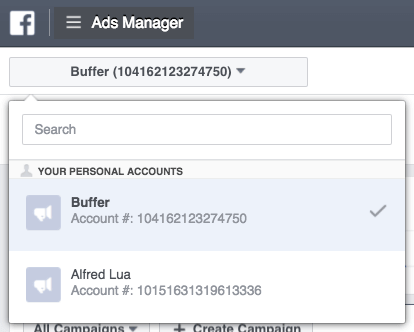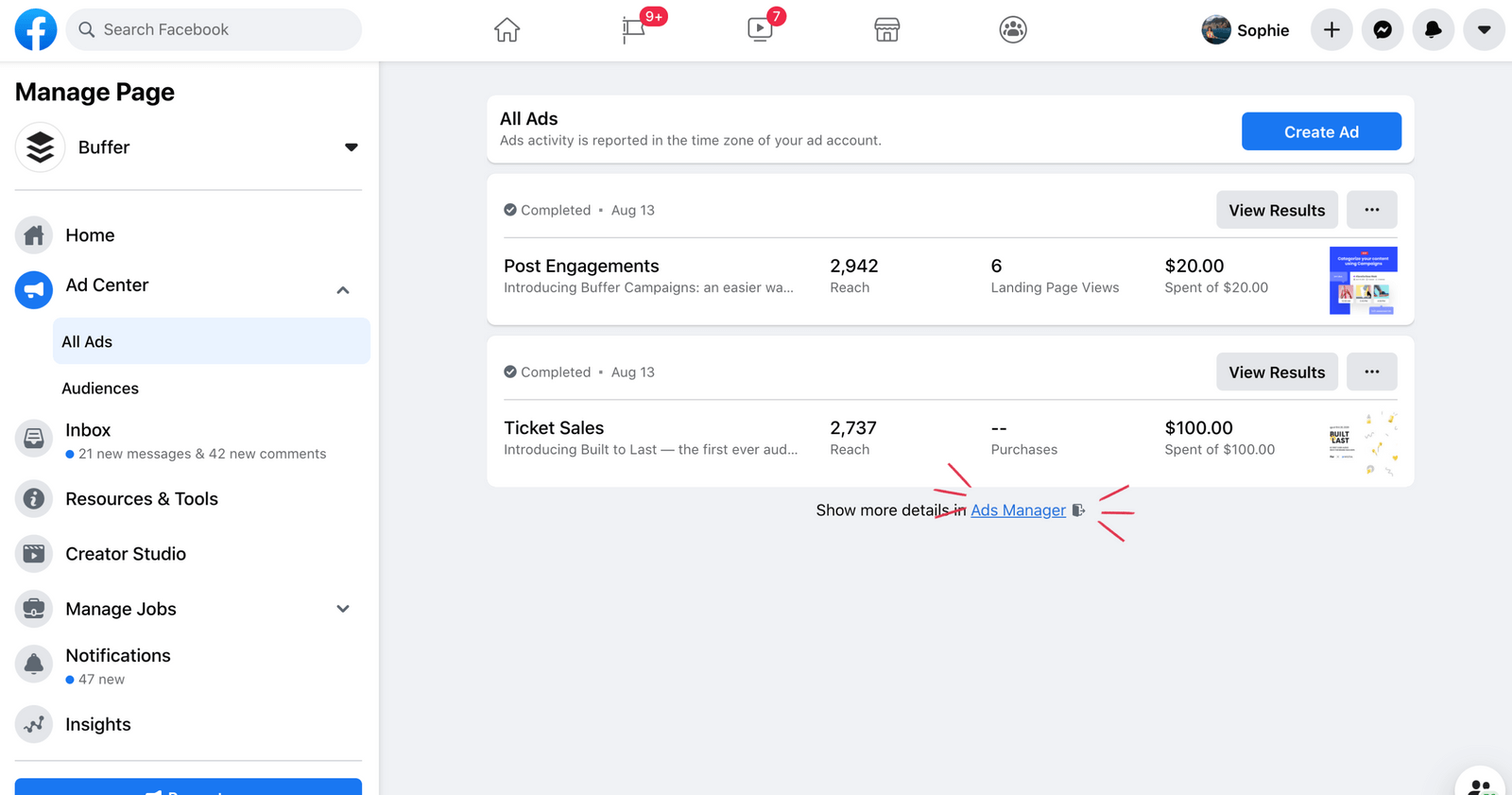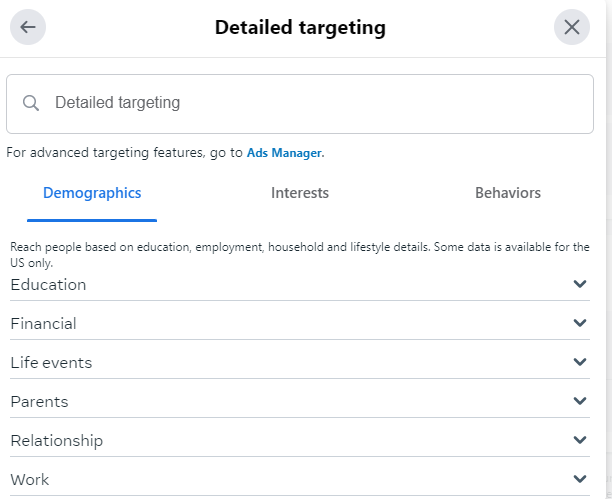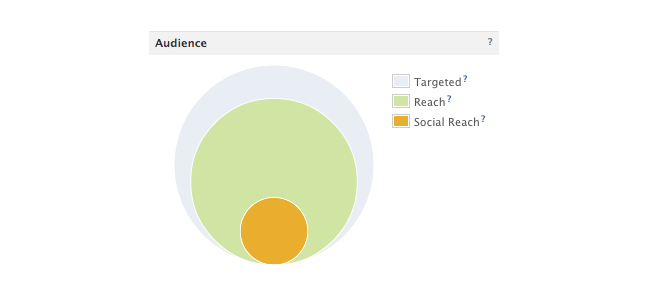A Complete Guide to Facebook Ad Management
- January 4, 2023
- Digital Marketing, Facebook, Inbound Sales, Social Media
Looking to outsource your Facebook Ad Management?
As a savvy internet user, you might think no one clicks on Facebook and Instagram ads.
You’d be wrong.
In 2021, Meta made over $114 billion in revenue from advertising.
Someone’s clicking.
But who, and how do you get them to click on your ads? I’ll show you.
Many marketers who tried Facebook ads, especially in their early days, decided Facebook advertising didn’t work.
Don’t believe them.
I will share everything you need to know about how to create Facebook ads, now known as Meta for Businesses.
If you’re totally new to Facebook, you’ll need to set up Meta Business Suite, then come back to this post for a deep dive into Meta advertising best practices.
In this advanced Meta advertising guide, you’ll learn which businesses are the best fit for the platform and how to run successful campaigns.
We’ll cover the most common mistakes marketers make and the biggest factor in your ads’ success.
In this blog post, we’ll run you through the basics of setting up a Facebook Ad and how you can manage it to be successful.
At The Serial Seller, we believe collaboration is the key to success, so any input you have regarding specific focus areas and the creative content will help ensure that we are delivering ads that are in line with your branding and business goals.
You will want to be advertising on Facebook or at least spending a bit of time on it…
The data shows that Facebook has a total of 2.7 billion users and people typically spend more than two hours daily on social media platforms.
If you’re looking for a great user experience, a fast interface, and easy-to-understand reporting, you’re in the right place! Facebook Business Manager is the right place for you!
How to set up a Facebook Ads campaign step by step
Before you jump in, it’s important to think about why you’re advertising and what you’re aiming to achieve. By determining your personal measurement of success ahead of going live with ads, you’ll be able to decide which ad objective is best for your needs.
For example, if you’re looking to increase downloads of your mobile app through Facebook Ads, your success metric could be 100 downloads in the first month. If you want to generate more leads, success could be measured by a larger email list. The point is, you should think about your reason for advertising before you create a campaign.
If you don’t already have a page, you will need to create one.
Create a Business Page
To create a Page:
- From the Pages section, click Create New Page.
- Add your Page name and category.
- Add your Page’s bio and click Create.
- (Optional) Add information, such as contact, location, and hours, and click Next.
- (Optional) Add profile and cover photos, edit the action button, and click Next.
- (Optional) Invite friends to connect with your Page, and click Next.
- Click Done.
Head over to Facebook Ads Manager
All of Facebook’s ad campaigns run through the Facebook Ads Manager tool. These steps are for using it on a desktop or laptop computer.
The easiest way to find Facebook Ads Manager is to click and bookmark this direct link. You will be brought directly into the Facebook Ads Manager for your personal ad account. If you manage more than one ad account, use the account drop-down menu to pick the right account.

To navigate to Ads Manager right from your business page, head to the left sidebar and click on the “Ad Center” drop-down arrow of any Facebook page, then choose “All Ads” from the drop-down. At the bottom of that page, there is an option to click “Ads Manager.”

You will be brought to your Facebook Ad Accounts page, where there will be a quick overview of your ad account(s). If you have access to more than one ad account, select the account where you wish to run ads.
If you’d rather use a mobile device, there is a Facebook Ads Manager app available for Apple and Android.

Who Should Advertise on Facebook (now Meta)?
Many businesses fail at Meta advertising because it’s not a good fit for their audience. So before investing time and money in Meta ads, consider whether your business model is a good fit for Facebook or Instagram.
In the past, Meta ads were more like display ads than search ads though new versions of ads, like product ads, allow advertisers to sell products directly to users.
Here are a few types of businesses that are likely to succeed with advertising through Meta.
How To Create Meta Ads For Businesses with Low-Friction Conversions
The businesses that are most likely to succeed with Meta ads ask users to sign up, not to buy. You must use a low-friction conversion to be successful.
A visitor to your website wasn’t looking for your product. They clicked your ad on a whim. You will fail if you rely on them to immediately buy something to make your ad ROI positive.
Meta users are fickle and likely to click back to Facebook or Instagram if you ask for a big commitment (purchase) upfront. Instead, stick to simple conversions like signing up for your service, filling out a short lead form, submitting an email address, or converting inside the platform using Instagram shopping or similar.
Even if you sell products, not services, you should consider focusing on an intermediate conversion like a newsletter signup. Then you can upsell later through email marketing or retargeting ads.
Daily deal sites like Groupon, AppSumo, and Fab are good examples of businesses that can succeed with Facebook advertising. After you click on one of their ads, they just ask for your email address. They’ll sell you on a deal later.
Business Model with Long Sales Cycle or Small Purchases
Even if you only ask for an email address initially, you’ll need to eventually make money from these users to be profitable.
The best business model that fits Facebook ads earn revenue from its users over time, not all at once. A user may have given you their email, but you’ll need to build more trust before they are likely to buy anything.
You shouldn’t depend on one big purchase. Several smaller purchases are ideal.
Daily deals and subscription sites are great examples of business models that can thrive on Meta. Both have customers whose lifetime value is spread out over six months or more.
At Udemy, they focus on getting users to sign up on their first visit. By aiming to be profitable on ad spend in six months (not one day), they turn Facebook users into long-term customers.
They target a 20 percent payback on ad spend on day one and a 100 percent payback in six months. These numbers can serve as a rough guide for your business.
Businesses in fashion, books and other small purchases also do well on Meta, especially Instagram.
How to Target Meta Ads
The number one mistake most marketers make with Facebook ads is not targeting them correctly.
Facebook’s ad targeting options are unparalleled. You can target by demographics and create custom or lookalike audiences to target users similar to your best customers. You can also use retargeting ads to target users who have interacted with your page or visited your website.
On Meta, you can directly target users by:
- location
- age
- gender
- interests
- connections
- relationship status
- languages
- education
- workplaces
Each option can be useful, depending on your audience. Most marketers should focus on location, age, gender, and interests.
The location allows you to target users in the country, state, city, or zip code that you service.
Age and gender targeting should be based on your existing customers. If women 25-44 are the bulk of your customers, start targeting them. If they prove to be profitable, you can then expand your targeting.
Interest targeting is the most powerful but misused feature of Facebook ads. When creating an ad, you have two options: broad categories or detailed interests.
Maximizing Investment with Broad Category Targeting
Broad categories include topics like Gardening, Horror Movies, and Consumer Electronics.
Meta also added targets like Engaged (1 year), Expecting Parents, Away from Hometown, and Has a Birthday in 1 Week.
Broad interests may seem like an efficient way to reach a large audience. However, these users often cost more and spend less. You’ll also need to install the Meta pixel.
This used to be an ineffective way to reach audiences because it targeted too large of an audience; however, adding the Meta pixel and dynamic ads makes this far more effective.
It is worth testing, but detailed interest targeting is often more effective.
Detailed Targeting: A Powerful Meta Ad Targeting Strategy
Detailed targeting allows you to target Meta users based on more detailed interests and onsite behaviors.

For example, you can target users based on the following:
- Ads they’ve clicked on.
- Facebook or Instagram pages they interact with.
- Activities across Meta, including things like which device they use or travel preferences.
- More detailed demographics.
- Speed of their internet connection.
Detailed targeting also allows Meta advertisers to include or exclude specific people using the “or”/”and” targeting.
For example, if you can target users who “are ” college graduates, you can then focus on those that “are ” interested in travel “or” interested in food. This lets you get a lot more detailed about your target audience.
Meta Ads Lookalike Audiences
In addition to targeting users directly, Meta allows you to target a group called Lookalike Audiences.
What are Meta Lookalike Audiences? These are Meta users that are similar to your current users. You’ll need to have Meta Pixel or other custom audience data, like an email list. Then, you can ask Facebook to find similar users.
They are highly customizable for example, you could create a “new customer” ad, then exclude current customers from seeing your ads.
This page on Meta walks you through how to create Lookalike audiences.
Retargeting with Facebook Ads
Retargeting ads allow you to reach customers already familiar with your brand. You can double down by creating dynamic ads that show people items they are likely to be interested in.
For example, you could retarget users who have visited your site, left items in their cart, or clicked on an ad.
To create a retargeting ad, the first step is to install the Meta Pixel. Follow this guide in Meta’s Business Help Center to get started.
Writing Successful Facebook (Now Meta) Ad Copy
After seeing your image, users will (hopefully) read your ad text. Here you can sell them on your product or service and earn their click.
Despite the 40-character headline and 125-character body text limits, we can still use the famous copywriting formula AIDA.
- (A)ttention: Draw users into the ad with an attention-grabbing headline.
- (I)nterest: Get the user interested in your product by briefly describing the most important benefit of using it.
- (D)esire: Create immediate desire for your product with a discount, free trial, or limited-time offer.
- (A)ction: End the ad with a call to action.
AIDA is a lot to fit into 165 characters, but it can be done. Write five or ten ads until you’re able to fit a succinct sales pitch into the ad.
Here’s an example for an online programming course:
Become a Web Developer
Learn everything you need to become a web developer from scratch.
Save 65%. Enroll now!
This tells users what they’ll get, why it matters, and why they should care in just a few lines.
Bidding on Meta Ads
Bidding Model Average Facebook Advertising Costs;
- Cost Cost-per-click (CPC) $1.00
- Cost-per-like (CPL) $1.07
- Cost-per-download (CPA) $5.47
- Cost-per-thousand-impressions (CPM) $7.19
Like on any ad network, strategic bidding can mean the difference between profit and a failed test on Meta.
After you create your ad, Meta provides a suggested bid range. When you’re just starting out, set your bid near the low end of this range, so you don’t waste ad spend on an untested ad.
If it doesn’t catch people’s attention, it will reflect negatively on your click-through rate (CTR) and conversion rate.
In regards to goal setting, look at your client’s website, products, and offers and see if there are any red flags that might hurt the performance of their Facebook ad campaigns and provide some recommendations if necessary on their website design that might be hurting their conversion rates for your campaigns.
Your CTR will quickly start to dictate the price you’ll need to pay for traffic. If your CTR is high, your suggested bids will decrease.
You’ll need to bid more for each click if your CTR is low. Optimize your ads and targets to continually increase your CTR.
In addition to click volume, your bid will also dictate how much of your target audience you can reach.
Meta provides a great chart for every campaign showing the size of your target audience and how much of that audience you’ve reached.

Increasing your bid will help your ad reach more of your target audience. If your ad is performing well but reaches less than 75 percent of your target audience, you can increase your bid to get more clicks.
If your audience penetration is high, increasing your budget will increase your ad’s frequency: how many times a targeted user will see it.
Meta also offers automated bidding that uses AI to determine what bids to make. If you use this strategy, make sure to keep a close eye on your budget so you don’t overspend.
Landing Pages for Meta Ads
Getting a click on your Facebook ad is only the beginning. You still need the visitor to convert.
Make sure to send traffic to a targeted landing page with a high conversion rate. You know their age, gender, and interests, so deliver a page that solves their problems.
The landing page should also contain the registration form or email submit box that you’ll track as a conversion.
Focus the landing page on this action, not the later sale. If you want visitors to sign up for your newsletter, show them the benefits or offer a free gift for their email.
How to Track Meta Ad Performance
Like PPC ads, you’ll want to track your meta ad performance. The exact metrics that are important to you will vary by the goal. For example, ad impressions and clicks are important if your goal is to increase brand awareness. If your goal is to increase your email list, then you’d want more actual form fills.
Here are a few things to keep in mind when tracking Meta ad performance.
Conversion Tracking
To track conversions, you’ll need to install Meta’s pixel. Make sure to track conversions for both specific ads and ad campaigns to get a deeper understanding of what ads are converting. Pay attention to both your ads and your audience—targeting the right audience often makes all the difference.
Performance Metrics & Tracking
You also need to monitor your performance within Meta Business Suite. The most important metric to track is the click-through rate. Your CTR affects both the number of clicks you’ll receive and the amount you will pay per click.
Ads with a low CTR will stop serving or become more expensive. Ads with a high CTR will generate as many clicks as will fit within your budget. They will also cost less. Keep a close eye on CTR by interests and ads to learn which audiences work best and which ads resonate with them.
Keep in mind: Even the best ad’s performance will decline over time. The smaller your target audience is, the faster this will happen. Usually, you’ll see your traffic start to drop off in 3-10 days.
When this happens, refresh the ads with new images and copy. Duplicate your existing ads, then change the image and ad text.
Do not edit the existing ad. Delete any existing ads not getting clicks. You’ll see the new ads accruing impressions and clicks the next day.
Monitor the images’ performance over time to see which generates the best CTR and maintains their traffic the longest. You can rotate high-performing images back every few weeks until they stop getting clicked at all.
Goal-Based Bidding
Goal-Based Bidding Based on the value you want to achieve Cost Per Result Strive to keep costs amount to the cost per purchase to stay profitable, but not guaranteed to adhere fully.
Use A/B Testing in Meta
A/B testing allows you to change variables in your ads, such as the ad copy, images, or audience, to see which strategy performs best. Meta allows you to create A/B tests in Ads Manager, so you won’t even need to use a third-party tool.
Instant Experience Ads
Using Instant Experience ads, users can tap through a carousel display of images, shift the screen in different directions, as well as zoom in or out of content.
Image ads are a good fit for campaigns with strong visual content that can be shown in just one image.
Facebook suggests using five to seven images and videos in each Instant Experience ad for the best chances of engagement
However, if you’re using URLs with specific UTM codes, you have an opportunity to measure your ads’ full-funnel effectiveness using your marketing software.
How much does it cost to advertise on Facebook?
There’s no hard and fast rule when it comes to Facebook ad budgets. The cost of Facebook ads depends on several variable factors, including:
- Audience targeting. It usually costs more to put your ads in front of a narrower audience as opposed to a broader one.
- Ad placement. Costs can change between ads shown on Facebook and Instagram.
- Campaign duration. The number of days and hours a campaign lasts impacts the final cost.
- Competitiveness of your industry. Some industries are more competitive than others for ad space. Ad costs usually increase the higher the product price is or how valuable the lead you’re trying to capture is.
- Time of year. Ad costs can fluctuate during different seasons, holidays, or other industry-specific events.
- Time of day. On average, CPC is lowest between midnight and 6 AM in any timezone.
- Location. Average ad costs per country vary widely.
The Serial Seller Summary
Facebook (Meta) ads are constantly changing and are extremely hard to stay on top of if it isn’t your primary role.
The great thing with Facebook Ads is that the range of campaign types and formats available are well suited to different stages of your sales funnel.
Early on in the funnel, at the top of the funnel, your main focus is on awareness and engagement.
In the middle of the funnel, your main focus is to start generating leads or purchase intent.
At the bottom of the funnel, your primary focus is to convert your leads or obtain purchases.
All of these objectives can be achieved through a range of Facebook ad campaigns. Campaign types can include brand awareness, video views, messenger, engagement website traffic, and website conversions.
We find the best success from Facebook Ads comes from having a multi-campaign approach so that you are simultaneously working on multiple stages of your sales funnel.
We have a three-tiered Facebook Ads campaign strategy in place targeting purchases at all stages of the sales funnel.
A smart Facebook marketing strategy is key to your overall Digital Marketing Strategy.
Because there are so many types of ads you can run with Facebook, with different objectives, there will be a combination that would be ideally suited for your business.
At The Serial Seller, we have provided a step-by-step guide on how to set up Facebook Ads Management for your small business. Our Facebook Ads Management service is personal, professional, and tailored to your needs. If you need to know about management packages or even If you need a bit more help than that, Book A Call With Us Now and we can provide ongoing services.
About us and this blog
We are a Full-Service Sales & Marketing provider that aims to help small to medium businesses increase their leads and sales while helping remove the business owners from their day-to-day activities so they can focus more on the long-term goals of their business.
Book a Meeting with us!
We offer Done-For-You Sales, Sales Coaching, and Advisory as well as Digital Marketing Services. If you want to increase the leads generated for your business and need some guidance and accountability, book a call with us now.

